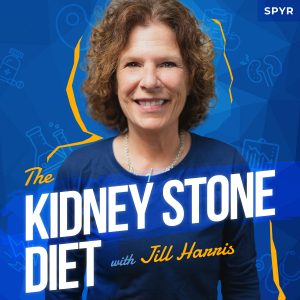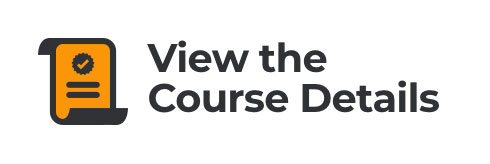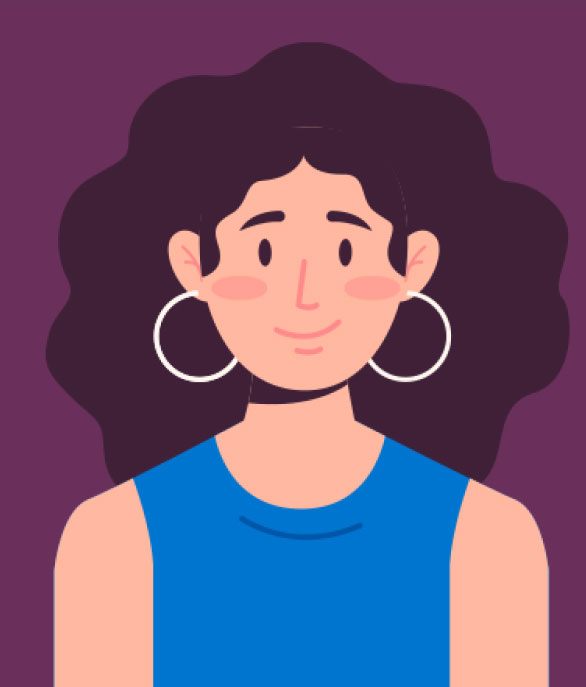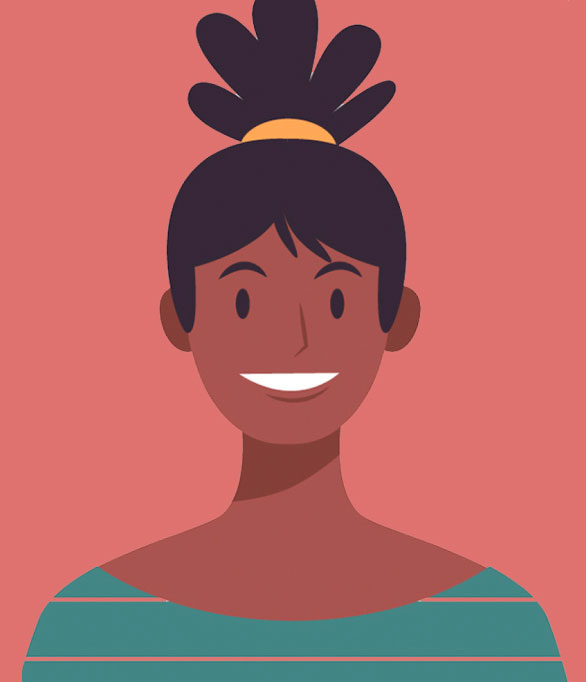This week Jill answers a listener question about the amount of calcium needed when eating high oxalate foods.
Jeff Sarris: Welcome back to the Kidney Stone Diet podcast, the show about reducing your kidney stone risk and living your best life. I’m your host and fellow student, Jeff Sarris.
Jill Harris: Hello! And I’m Jill, your kidney stone prevention nurse, and I’m happy to see you, Jeff. How are you doing?
Jeff Sarris: Yeah, it’s great to see you. I’m doing good. This is our first time we’ve talked face-to-face in 2022, which is wild. That number–does that number just get to you?
Jill Harris: Dude, I was born in 1963, so to me, I’m on Mars right now! Like, I don’t even know from this number, right? I mean, you’d watch TV shows back in the day, about 2022 and you’re like, “Oh, who the hell can think of that?” And here we are: 2022. It’s pretty amazing, especially since most of us have spent that inside the last couple years. So, it’s like it’s a blur, right?
Jeff Sarris: Yeah, and it’s funny when you go back to movies and things because like in Back to the Future, the future was 2015. And I’m like, “Oh, God, we’re past the future in that movie!” It’s so weird.
Jill Harris: That’s such an awesome point. We’re past the future in this movie. That’s amazing. That’s amazing. Yeah, it’s crazy. I mean, every year we feel that way. Like, “Oh, my god, time’s going so fast!” But I’ve said this before, it’s like the older you get, it just feels like–remember when you were teeny, tiny little Jeff and you were like, “God bless–” maybe you didn’t say it exactly this way–but you’re like, “Wow, I’m bored. It’s, you know, June 12.”
You just get out of school. It’s a week later, you’re like, “What am I gonna do with all this time?” Now, as summer goes, it’s a blip. It’s just a blip in time. It’s amazing, isn’t it? Well, if you think about it, maybe–Jeff, I’ll let you talk when I’m ready, okay? This ain’t about you, Jeff. It’s about my story about little Jeff. I don’t even know what I was gonna say now. What were you going to say?
Jeff Sarris: I was gonna say because it is that ratio of, sort of the–one summer, in a life of like a seven year old, that’s like one seven of your like,–it’s a huge percentage of your life. It’s 1/7 of all the summers you’ve had. You don’t remember most of them. So, it’s such a different perspective as we get older as we age.
Jill Harris: I’m so happy that you said it because that’s what I was going to say, and you said it’s so much more sophisticated than I. So that’s awesome. Yeah, and I’m 58, so a summer to me is like, I mean, one piece of 58. Who notices that, right? So it’s interesting, the older we get. It’s just a little sliver of our life and that is why we really need to be grateful every time we get up and we have a breath to take, right? I mean, it’s so important. It really is.
Jeff Sarris: Yeah, there’s only so many, so many that we get. And that’s a good shirt! I like that, “And I still rise.”
Jill Harris: Okay, I did a Facebook live today and I use it–so I put this shirt on. This is from Nike, and somebody gave me this for Christmas and they’re like, “You’ve been through a lot of stuff in your life and you’re still here. So I, I thought of you when I saw this shirt.” And so I love it because it reminds me of all the things that I have been through in my life. So when I am having a hard day, I’m like, “Look at all that stuff I just got through. If I got through that, I can get through this because here I am and I feel great.” So, you know, it’s just a reminder that no matter what we’re put through in life, you can always get through it. You really can.
I’m not saying it’s easy, but I’m saying that there is always another side if you give yourself enough time. You know, time really does heal everything. So, like right now, I could go down the street and I can actually walk without crying because I miss Luke. And I mean, I wasn’t like, crying like a hobo in the street. I mean, just tears would naturally come down my face and now I’m just like, “I miss him.” And it’s just time. It really does heal and, you know, I just take a lot of solace in that. Every time I face something I know that it’s gonna suck right now, but I’m gonna get through it. So I love knowing that, right?
Jeff Sarris: Yeah, for sure. It’s so valuable because yeah, what we’re what we’re experiencing now we want to be here now, but at the same time when it’s a tough time now, knowing it’ll pass is valid is just a valuable perspective to have. I think that’s great.
Jill Harris: Yes, it is! And also, what gets me excited is all the things you learn from that. Like, I’ll use Luke because that was my past hard thing, and my most recent hard thing. So people are like, “Well, just get another dog.” And I’m like, “I know I have to get another dog. I want Luke. I’m grieving Luke. Not a dog, right? Not not just any dog.” And any dog I have, he could be two legs and no eyeball, I’m gonna love that dog. I mean, that’s just who I am. It don’t matter. I know that I could love another dog again, but right now I’m grieving my Luke. Luke, exactly who he was, right? So, that was so amazing. And somebody also said people are like, “Jill, you’re supposed to be talking about kidney stones?” I know I’ll get there.
This all has to do with eating well, living a healthy lifestyle, are you not getting enough sleep? Did your dog just die? Stress, blah, blah, blah. The things I talk about, I know it seems like I go off on a tangent, but it always has to do–living a healthy lifestyle is way more about than just eating broccoli, okay? It’s why we’re choosing the things we are or are not. And so, about Luke, what made me–what was so interesting to me, as someone said, “Well, Jill, I mean, honestly, for the last several years, that dog was your partner.” And I’m like, “He really was my partner. He was my partner.” Some people may be like, “Well, that’s friggin’ sad.” But it’s not sad to me.
He was my partner. Twenty-four hours a day, work, vacation, in the car. I mean, he was my partner. So, it’s such a beautiful thing to know that you can love something or someone that much that you get to grieve over it. How lucky are you? Now I didn’t get there. I wasn’t here when I was going through that, but now that I’m out of it, I can think like that. I feel so blessed. Do I want him to be gone? No, but look at all the valuable things I learned with his passing. So, that’s where I always end up in life. I don’t know. That’s just where I go, right? So it’s amazing. It was hard, but I feel like I’ve grown more. I’m a better person for having known that animal and that kind of love and it just gets me through something else better.
Jeff Sarris: Yeah, absolutely. Yeah. I mean, I think that’s a wonderful perspective on all of it. And, we have actually a lighthearted voicemail that I was gonna start with today, which I think is a perfect transition for us. But you will know, you’ll know right away.
Jill Harris: All right.
Listener Voicemail: Hey, Jeff. This is Margaret from Naperville, Illinois. Happy New Year, Jill and Jeff. You guys are great. I don’t have a question because I already know the answers as I watch your show every day. And yes, Jill, I was yelling at the TV when you were adjusting your collar on the episode about sugar. I thought for a minute that you were caught on air while you were still dressing. I said to Bobby, “What the hell is she doing?” If I wasn’t such a busy lady, I’d join you on your show, but I’m busy trying to keep all your siblings on the Kidney Stone Diet. However, I would like to meet Jeff. Happy ’22! Love Mom.
Jill Harris: Oh my god. Okay, so first of all, she’s so busy. She’s saying that because she gets up, she makes her coffee, and she sits in her chair till she goes to bed that night. So that’s her busy, but that does keep her busy because a lot of her grandchildren and people live with her. She’s like the Italian mother where everyone lives under and she loves that. So don’t think she doesn’t. So, and again, any way that she can get her ass or her voice in this case, on this show, she’s gonna try to think about it. And yes, she is in love with Jeff. As is everybody and Jeff don’t say, “Oh, no,” because everybody is in love with Jeff. Yes, it’s true. That mother of mine, she’s the best.
Jeff Sarris: Yes, she’s awesome. As soon as I–at the beginning, because I always read the transcript because in our voicemail app, it shows me so I can sort of skim it and see, and at first I was a little confused because this isn’t–I don’t know who this is. I saw that it said mom, and it referenced me first and I was like, “Wait, a minute! Oh, that’s Jill’s mom!”
Jill Harris: Yeah, she’s gonna sneak up here, people. Like I said, the nut don’t fall far from the tree, and I’m glad that it don’t.
Jeff Sarris: But yeah, I wanted to start with that. I couldn’t let that one go too long. But yeah, so actually, we’ll dive into the the actual kidney stone-specific question. This is coming from Lauren and, again, if you have a question, the number is 773-789-8763. And we’ll feature you on a future episode. But let’s dive into today’s question.
Jill Harris: Okay. Let’s go.
Listener Voicemail: Hey, this is Lauren. I’m from New Orleans, Louisiana, and I was wondering if there was a calcium to oxalate ratio that would be best for that binding mechanism to happen to prevent kidney stones.
Jeff Sarris: So I’m cutting it off just because she left her number at the end. But yeah, so we’re looking at a calcium to oxalate ratio, and that’s from from Lauren.
Jill Harris: Lauren from Louisiana. Hello, Lauren, and thank you for your question. So, this is very common; very, very common question. So, it goes like this: I get a patient. We go over their urine, their 24-hour urine collection, and I start educating them on calcium because no one gets enough calcium. Nobody, until they start hearing about it because of my big mouth screaming about it with kidney stones. And so there’s one reason I like kidney stones, and it gets people motivated enough to find somebody who can help them because that pain for most people is something that they will never forget. And so pain is a powerful motivator. So, when I’m going through their urine collection, I will talk about the calcium part of the Kidney Stone Diet and why it’s so very important.
The Most Important Thing to Know About Treating Kidney Stones
They don’t care about nothing I’m saying all everybody cares about–”Okay, I hear you about everything else. Why are you waiting so long to talk about oxalate?” Because it’s the least important thing. “How could it be? My stone is calcium oxalate.” But there’s a lot of reasons why it’s that way. It ain’t just because of oxalate. Oxalate is important until you learn this sentence: stay away from spinach and almonds. That’s all you need to know. “Henry, did she say I could have a sweet potato, then?” Well, there’s more to talk about. You can have higher oxalate foods, if you eat them within portion size.
If you found me because your oxalate was super high, it was typically for two reasons. You have malabsorption issues from Crohn’s, colitis, bowel disease, a whipple (which is a very intense surgery), a gastric bypass, you have other malabsorption issues going on. Just not eating spinach and almonds ain’t gonna clear you, for the most part, for low-oxalate urine levels. That’s a little part of the equation. The bigger part is that people– this is the common scenario. “Jill, I was diabetic. So they told me, I need to have spinach and eat as many almonds as I want and that’s what I did. And eat lots of meat protein, by the way.” So the deal is that when we health professionals tell patients to do something, we really should be a little bit more specific because what we say generically, well, patients can interpret any way they want.
If someone says eat almonds, all the patient hears is, “Oh, shoot, I’ve got diabetes. They said eat almonds. Clif, go get bags! Go to Costco, honey, we need almonds!” That’s what they said: every day, all day almonds. That will cure my diabetes. So, what we tell patients, and what patients hear are two different things. And, quite frankly, in today’s healthcare industry, there is no time to be sitting around, wiping a brow, holding a hand, telling a story about how to do something. This is why Jeff and I do what we do. Because we set aside the time. We make time. We’re in a profession and a business that we can take as much time as we want.
How Does Calcium Get Oxalate Out of Your Body?
I don’t have to work–we do not have to work in the constraints of a setting where you’ve gotta see 35 patients in four minutes. So, we’re very happy here. So what I’m saying is the other set of patients with high oxalate they ate as much spinach as they wanted because why not? More is healthier. They had as many almonds–they just ate a lot of high oxalate foods that are typically healthy foods in any amount that they wanted, along with no calcium source. So, when we overeat oxalate what happens is we metabolize it.
We want to get rid of the excess of everything we’ve eaten, the rest goes into our intestines goes into our colon and is getting to leave as waste goes through their stool. The only way oxalate can leave your body is to bind with calcium in your intestines and leave through the stool. If you are not eating enough calcium products, then what happens to that oxalate is he looks around and he’s like, “Oh shoot, there ain’t no calcium here in this colon. I can’t leave how I normally want to leave.” So it gets reabsorbed back into your bloodstream and you get higher oxalate levels. This is a very sophomoric view on what’s going on, but it works for most people. We don’t really need to get elaborate here, people.
The point is, with all foods, healthy or not, moderation is key. And, unfortunately, a lot of you Stoners have found that out the hard way. And what’s really depressing and not just depressing, but defeating is like, “I just changed my whole diet and I caught this stone because I’m eating healthy now?” But, again, all food within moderation. There is no superfood no matter how much people want to say this is a super food. Eat all food, a variety of food in normal portion sizes. And that includes getting your calcium because you have to feed your bones that need it so you don’t get osteopenia, which is the beginning of osteoporosis, and/or osteoporosis. So, you need it for your bones and you need it to get rid of excess oxalate.
So when people come to me, they’ll say, “My oxalate’s really high. This is why I changed my diet.” I tell them, “No more spinach. No more almonds. Get your calcium needs met every day.” Now, with that advice, I have to be very clear because what I’ve seen in the past, is if I just left the advice there–keep your oxalate under 100 milligrams a day unless the doctor has told you otherwise, and get your calcium needs met, and the only way you can get rid of excess oxalate is to have a bind with calcium–well, if I don’t extrapolate on that, you can imagine what the next urine collection’s going to look like. The next urine collection’s going to be their oxalate level is very low, which is wonderful, and their calcium level is now super high because they’ve overdone–”Get to it, Jill!” I’m getting there, hold on.
Because now every time they had two milligrams of oxalate, they were running for a glass of milk. “I don’t do dairy, Jill.” You don’t have to. You could do non-dairy sources of calcium. Either way, the patient has now taken it upon themselves because if I did not do my job as thorough as I do–and the only reason I do is because I’ve had so much experience, I know what human beings are going to do if I don’t extrapolate, okay? So I’m lucky I have 22 years of experience in this. So I know what’s going to be done if I don’t open my big mouth. So, I tell patients that, “Hey, I know that you’re gonna want to have some milk or whatever every time you have two pieces of oxlate, but don’t do that!” Your body can’t absorb all that calcium and it’s gonna wind up in your urine. And the next thing you know, your doctor is gonna be like, “Holy braciole, your calcium is so high in your urine! Get them a pill!” You don’t want that.
So, What is the Best Calcium-to-Oxalate Ratio?
So, the question is, finally–tick tock girl, they got places to be. Okay, what is the ratio?How much calcium should I consume when I’m having anything with oxalate? So, there is no ratio. “Really, Jill, you made us wait all this time?” But, wait, hold on, I got some interesting things to say to you. Why is there no ratio? Because we all absorb things differently. Say I have the flu and I have diarrhea for a week. I’m not absorbing everything I try to put in my body, okay? So it doesn’t matter what I do. We absorb things differently. If somebody has a gastric bypass or bowel disease, they’re going to absorb things differently than me.
Jill’s Simple Rule to Know How Much Daily Calcium to Get
So is there an exact science to this? A hundred percent no. That would be no. So here’s some rules I put around things. And the outcome has been good, because I’m looking at follow up urine collection. So I pretty much trust the advice I’m giving. It hasn’t kicked me in the butt in a couple of decades, so I’m going with it. Because I know people like some kind of rules, some kind of guidance. So men and women that still get their periods need 1000 up to 1000 milligrams of calcium a day. Women who are done with their period, up to 1200 a day. “Up to,” people, not over. More is never better, unless we’re talking about water. So, that. Now, spread it throughout the day. Because, again, your body isn’t going to absorb–”Jill, I don’t wanna do it throughout the day. I don’t remember. I’m gonna have three glasses of milk for breakfast.” Don’t do that. Your body’s not going to absorb it.
And the point of having calcium is so your bones can absorb it. So you want to do that. It doesn’t want to take it all at one place. And so here’s what I do. I drink pea milk. I drink unsweetened coconut milk. I’ll drink lactose-free milk. It depends what kind of milk I’m looking for. Do I just want calcium? Do I need extra protein that day because of my body-building stuff and I didn’t get close to my protein needs? I’ll go to the pee milk. It has eight grams of protein. Is my stomach doing okay? I’ll have the lactose-free. There’s 14 grams of protein. So, I’m juggling a lot of things just as everybody else is. So there’s different types of milks or non-dairy milks you can have that you can easily meet your calcium needs. I typically get–I drink a cup of milk three times a day. It’s close enough to my 1200 without going over. I also eat a lot of vegetables, so I’m going to get bips and boops of calcium as well.
Now if I am having–say I want a snack of a sweet potato. Half of a sweet potato and a grilled chicken breast and that’s a snack for me. A little snack. A smaller piece of chicken and a fourth of a sweet potato. I know sweet potatoes are high, higher than five milligrams of oxalate. So I might pair half a cup of milk with that excess oxalate I’m eating. How do I know what I’m absorbing? I don’t! I don’t know if I have a little bit more oxalate in my system or not, but the point is when you’re always sticking under the 100, it don’t matter people. The point is you were suckin’ down spinach like it was candy, so you were having hundreds and hundreds of milligrams of oxalate with zero calcium.
Now the average person gets about 200-250 milligrams of calcium a day. They’re not thinking about it. It’s just in their foods, but that ain’t gonna absorb any excess oxalate. So that is why there was a stone problem. So once you take away the things like eating as much almonds as you want, and spinach, and you meet your calcium needs, you ain’t gonna have an oxalate problem. Again, I watch and look at thousands of urine analyses every year. So I know what I’m saying is solid. So the advice as far as the calcium-oxalate ratio: if you’re having something–if you’re gonna have a peanut butter sandwich as a snack, put your cup of milk there. But if you’re not having any oxalate at dinner, or like less than 10 milligrams of it? You don’t gotta be running for your cup of milk, unless you haven’t had it all day.
So what I’m saying, basically, there is absolutely no formula. But because I know you all like rules, I say this: if you’re having something 20-25 milligrams of oxalate or higher, put some calcium with it. Just a generic rule that I have made up. I have no data, but it has definitely seemed to work for my patients. And it gives you something to strive for because I know patients get very anxious. Not a judgment, simply an unfortunate fact, after the hell they’ve been through, they want some kind of concrete something that they can go by to ensure that they are doing the very right thing in order to minimize their stone risk. The end.
Jeff Sarris: Yeah, I mean, I think that’s all so valuable. I wanted to rewind just to the point that you made about having spinach. Spinach is healthy, but that is like, “Okay, I want more health, I have more spinach.” But then how you can so easily flip to the other side. “Now I need calcium, I’m going to have so much calcium.” It’s the same exact mechanism. It’s just how we’re wired, but, yeah, there isn’t–it’s not like one is better than the other. For stones, obviously, the oxalate in spinach is a no-go. But yeah, we can do harm with good foods, just as we can do harm with bad foods.
Jill Harris: Yep, and I think that’s why this is so frustrating for so many patients because they worked so hard to change their diet, and they thought they were doing the correct thing. But, truly, when people don’t have–and this has nothing to do, this is my profession. I’m just saying the state of the world, there’s just not time and it costs so much money to really be able to sit with somebody week after week after week. Who can afford that? So, you know, people need more than just a brochure thrown at them or here’s a 1200 calorie-a-day diet. Chicken and lettuce all day long or spinach is good for you. So people are going to take that because they’re so petrified of making another stone or having issues with their diabetes or all the things they’re going through that you can lose common sense.
So if there’s anything I do, I think it’s to provide some common sense to this terrible disease state of kidney stones that people are like, “Yeah, I totally get that. I don’t know what I was thinking.” But when you’ve been really sick and with kidney stone patients typically it’s just comes out of nowhere, it’s so sudden, it’s so scary. So a lot of common sense. You know, when I was going through my cancer and thank God I do what I do for a living so–but even with me as I was going through my cancer stuff I had an ileostomy and that was, while my colon was healing from a surgery, it would divert my stool outside my body in a bag. I had that for several months and when I got to taken down, I didn’t have to eat the way I was, which is a very high-carb diet at the time of having that appliance. And I know this. I know this. I work with these patients. That was the kind of nurse I was at University of Chicago. I dealt with my disease state.
But I was so freaked out by everything I went through, I kept eating the same way. And one day I woke up and I’m like, “Oh, my God.” And so all the things I learned during my disease, I bring out to the world, it’s like, “Man, you’re so not alone.” It doesn’t matter how smart you are, or what you know, when you are scared, it just doesn’t matter, you don’t think quite right, you know? You’re just so afraid of getting sick again, that common sense can go out the window. And so I like to think that that’s what we’re providing here. We’re providing, of course, stuff that’s based in science, but also some common sense, practical tips that people can leave our show with and go, “I got that! I got that.”
Now I know if I’m having something like 20 or 25 milligrams of oxalate–and by the way, if you don’t have milk at that meal–again, people, your stone was grown over months. A long time. It didn’t happen in a meal. So, I want you to remember that. Again, not to shame you, but to remind you, so you don’t get so anxious, okay? Because I understand the anxiety of illness. So yes, it is very interesting what we do as humans, and it makes total sense to me, because I’ve been through it myself. I understand.
Jeff Sarris: Absolutely. I think that’s a great spot to wrap on this episode. Thank you, Lauren, again, for your question. And if you have a question, the number is 773-789-8763, and we will feature you on a future episode. But yeah, you mentioned the urine analysis and I wanted to just mention that because that’s such an important thing. And you have the urine analysis service, so that’s on the website at kidneystonediet.com. It’s sort of the first place you want to go, generally, when you’re trying to figure out, “Okay, what type of stone? What’s going on with my system?”
So, like, if you wanted to dive into that service, it is a paid premium service, but it’s at kidneystonediet.com. You can find all the other free stuff, the the email newsletter, which is sent out every Saturday, a link to the Facebook group that’s really thriving. There’s so much going on there every day. And there are all the free blog posts and everything, but all of that can be found in kidneystonediet.com. So, yeah, I think that’s a good spot to wrap and thank you again for listening, for watching wherever you are. And we will see you next time!
Jill Harris: We love you guys! Thank you, Lauren. That was a great question. A very popular one. We appreciate you. Thank you!














Leave a Reply